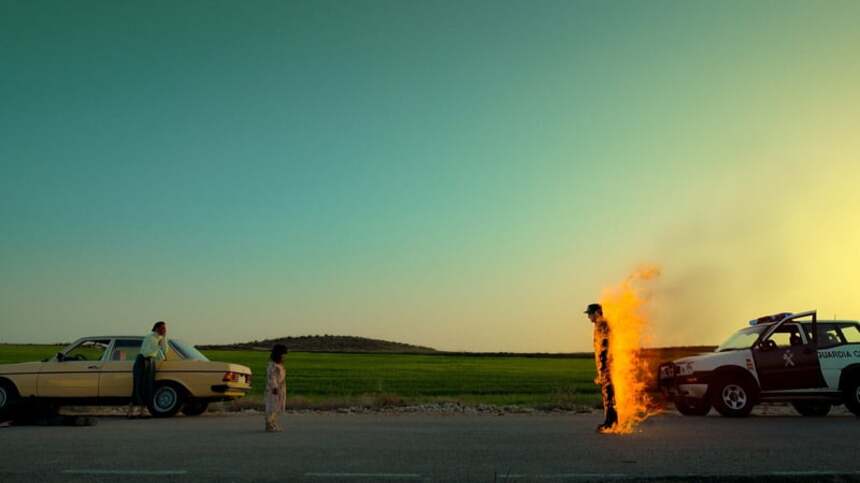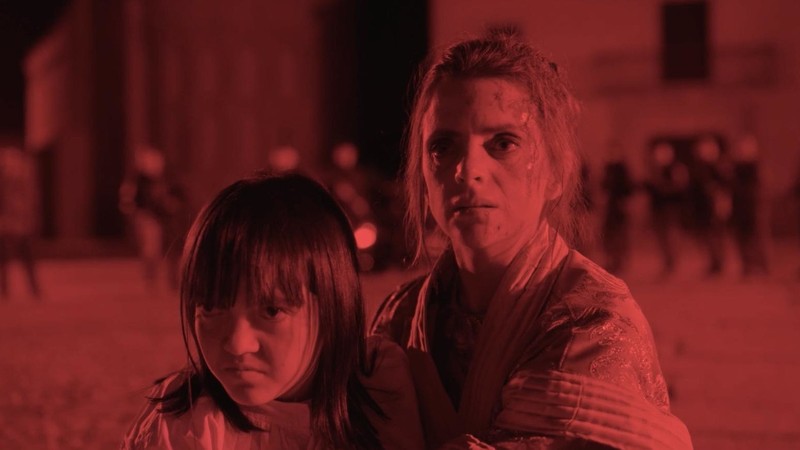EVERYONE WILL BURN Review: Visually Stunning, A Narrative Mess
Macarena Gómez stars in David Hebrero’s second feature

I've never understood why small towns are so often praised as better places to raise children. Contrary to the popular belief that they are kinder and more welcoming, smaller places tend to be more isolated, and therefore more prejudiced, more close-minded, more stuck in superstitions, more apt to violence against anything they understand.
Small towns like this are perfect places for dark legends to grow, hatred to fester, and rage to simmer until it explodes. David Hebrero's sophomore feature Everyone will Burn focuses on just such a town in the Spanish countryside. Where townsfolk believe that anything 'odd' doesn't belong - which too often translate into anyone who looks different or acts in a way that the town arbitrarily decides is wrong. And while a visually stunning film, the story takes so many twists that it loses its power.
The film begins with a legend and a bang. This town, forty years ago, allegedly killed a child in order to expel some unexplained evil and prevent the apocalypse. Cut to today, and María José (Macarena Gómez) is dressed in her Sunday finest, standing on the stone ledge of a bridge, ready to jump. Suddenly, a child (Sofía García) stops her: this normally would be cause for celebration, except the child is not María José's, and she is covered in dirt. María José is understandable shocked: the reason for her attempt at suicide is that she is unable to reconcile with the suicide of her son, who like this child, is a dwarf. There is more shock in store, as María José and the child, whom she names Lucía, are pulled over by the police. When one of the officers becomes rough with María José, the child showcases her telekenetic powers, which leaves both officers violently dead.
This sets off a few similar incidents: a group of teenage boys who bully Lucía find themselves hospitalized with various illnesses. Tito, the young man that María José believes drove her son to suicide, is drowned in a toilet. It seems 'Dad', whomever that is, is driving Lucía to these acts in an attempt to protect María José. She has always been a target in her town, looked on as a kind of witch, in large part because of her son's condition. Her neighbours, including the Mayor's wife, now think Lucía is part of the fulfillment of the prophecy they sought at avert 40 years ago, and they might have to now kill again.
The first half of the film moves swiftly in the horrific and steady pace. As Lucía's power grow in strength, so too does the dread that comes with them. There's an uncanny and deeply disturbiing moment when María José only briefly overhears Lucía talking with 'Dad' and we can make some guesses as to whom that might be. Her fervent need to protect the woman she calls 'mother;' is matched by María José's decision to take this child as her own. If she hasn't already sold her soul to the devil, as the townspeople believe, she would now. And we want María José to have her revenge on those who would bully her son into suicide just because of his stature.
Gómez has always been able to sell high melodrama, and her performance here is terrific as always - her grief knows no bounds, as it wouldn't with any parent who has lost a child to prejudice and terror. García is equally terrific, holding her own and making all of her scenes have the necessary creepy undertone to balance the melodrama - we want to embrace this child, even as we are terrified of her. The rest of the cast embraces the melodrama and horror with aplomb.
And this is a visually stunning film. Hebrero (himself having worked extensively as a director of photography), co-cinematographer Ona Isart, and production designer María Ona create a dreamscape that is the deliberate opposite of the tone: this is the small town as everyone thinks it is, as they want it to be, with beautiful reds, yellows, and blues, sun shining, a kind of retro moment in time. As the townspeople wish to exist in a false sense of safety and conformity.
The trouble is, what this terrible prophecy is, what is means to the town, what will happens if it comes true, is never made clear and seems to change with each page of the script. What begins as a revenge story, of this individual, on the place that has given her rage form in this power4ful child possibly in league with the devil, makes for a great story. But then, that story is taken away - suddenly somehow it has to do with the local Priest and a child he fathered (hardly a great scandal in a country likely full of priest's illegimitimate children); or there are supposed to be a pair of children? María José's ex-husband shows up with his new, pregnant wife, and it seems Lucía sees him as her father - but the townspeople trust him even though he was the father of the previous child ... it gets confusing, to say the least.
And while a film doesn't have to explain every aspect of its narrative in detail, we're supposed to be afraid of what might be coming, or at least have an idea of what to fear, and by the time the second half hits, it's unclear. It then becomes a series of seemingly unconnected moments that are cobbled together without any regard to how the pieces fit together - whatever this prophecy is, you don;'t know what it means or why you're supposed to be scared. You keep waiting for the hammer to drop, and it never does - it seems to have bee forgotten down some path, while the story takes so many detours that it gets lost in its own mismatched symbolism. The horror seems to go missing in favour of the visual style, which gets repetitive, and the pacing far too slow to earn its near two hour running time. In the end, the title doesn't even seem to be metaphoric or symbolic - there is not a lot of death, and even less burning.
Everyone will Burn has something to recommend - a powerful opening, terrific performances, and glorious colour. However, its story becomes too convoluted and, in the end, incomprehensible to make its horror palpable and enjoyable.
Everyone will Burn will begin a theatrical run at Alamo Drafthouse theaters in New York, Los Angeles, and Austin, beginning on December 1st, followed by a digital release on December 5th.








